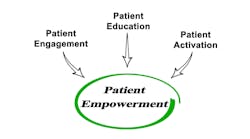The New Healthcare Marketing Has (Finally) Arrived
Managing Editor Rajiv Leventhal conducted an excellent interview published last week, with Don Stanziano, Director of Marketing at the Danville, Pa.-based Geisinger Health System. As Leventhal wrote on March 5, “As patients are now becoming more active participants in their own health, C-suite organizational leaders are deploying strategies to help ensure their hospital or health system stands out from the pack by delivering a modern patient experience. A big part of that process has included getting healthcare marketing teams involved at the table, as forward-thinking organizations are now realizing that meeting and exceeding patient expectations has become an imperative goal.”
And, as Stanziano told Leventhal, regarding his position, “My responsibilities include all aspects of marketing and communications for Geisinger, and that’s inclusive of digital customer engagements and strategies. So that means some of the more traditional things that you’d expect marketing to have responsibility for—the public-facing website, social media efforts, and digital marketing efforts. More recently, that has also included our patient portal, which our version of Epic’s MyChart— myGeisinger—as well as some mobile apps that are consumer-facing.”
With regard to marketing emerging in a new form nowadays, Stanziano said in the interview, “I have been in healthcare since the 1990s, in communication and marketing roles, and I would tell you that as a vertical, healthcare as changed dramatically. I remember presenting to doctors and leadership 10 to 15 years ago, using the word “consumer,” and I would get challenged. They would say they have patients, not customers. Today,” he said, “that isn’t a debate. ‘Consumers’ in healthcare is a term that’s very much understood, and that’s a good thing. Marketing has been one of the champions of that thinking and changing that perception, along with patient experience teams. Marketing has changed so dramatically in the last decade or so because of the digital channels we now have available to us.”
As Stanziano noted, “Healthcare is just catching up in terms of what we’re now able to do, and the disruption that has occurred as the result of digital capabilities and the empowerment of consumers. And we see this in every aspect of our lives. Retail is now undergoing a massive change because people are shopping online. Healthcare is at that precipice where digital capabilities, challenges and technologies, and the consumerism of our customers, is really driving dramatic change. Marketing is at the table for all of this. We have the discipline and sensitivities to message people, leveraging the right channel at the right time for the right customer, so it’s a very exciting time to be a healthcare marketer.”
I think that Stanziano is exactly right; and what’s more, his understanding of the position and opportunity available to healthcare marketing in this moment, is precisely on target. I remember what hospital and health system marketing was like 25 years ago. Compared to what’s possible now, healthcare marketing back then was primitive in three distinct ways. First, it was all about luring healthcare consumers/patients into interaction with, and loyalty towards, usually, individual hospitals—and occasionally broader integrated health systems. And second, it was for the most part divorced from any broader patient engagement. Both of those elements reflected the fee-for-service-based healthcare system of the 1990s, a national healthcare system whose providers were constantly incented to fill beds and medical group exam rooms. Second, the concept of population health management didn’t really exist back then, in that FFS-based payment and delivery world, so building connections with patients really was about filling beds, rather than engaging patients in their care management. And third, of course, the industry lacked the information and communications technology we have now to create what the social media mavens call “stickiness.”
With regard to the tremendous potential of this moment, I’m thinking right now about a presentation I saw three years ago at he HIMSS Conference in Orlando. In that instance, a health plan in Colorado had teamed up with a major integrated health system, so that the health system could be a beta site for testing an intriguing new consumer-facing app. That app guided consumers diagnosed with heart disease or diabetes, to be able to evaluate local restaurant choices, based on actual posted nutritional information in the restaurants’ offerings (not just descriptions of dishes). During the presentation, they showed a brief video interview with a young man who was about 22 at the time, but who had suffered a major heart attack, and had had stent surgery, about his use of that app. It was quite fascinating, particularly the engagement that the young man had developed, with both his care team, and the health system, based on his interactions with the app.
Now, that is just one out of limitless potential stories out there in the healthcare world; but it does illustrate the potential out there, as all the planets are aligning now, around population health management. Marketing, as Geisinger’s Stanziano noted in his interview with Leventhal, can be so much more, now that the concept of the healthcare consumer is coming more into focus—and that we have the incentives to engage with consumers on a new level, and the technology to be able to do so successfully and to good effect.
And, now, finally, healthcare marketing will be able to be repositioned as something that adds value, rather than simply adding cost, to the overall U.S. healthcare system. And that will be a game-changer for healthcare marketing professionals, for c-suites, and for the industry as a whole.


